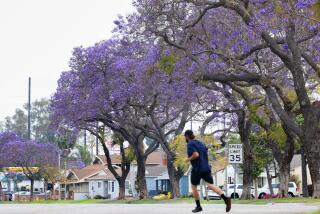It’s Wistaria (or Wisteria) Time
- Share via
Wistaria are coming into bloom. For that matter, the world’s largest one in Sierra Madre has been blooming for a fortnight. Altogether, they are a lovely addition of lavender, purple, pale blue, even pink, to the other colors of spring.
To the botanist wistaria are wisteria , according to Jim Bauml, the senior biologist and plant taxonomist at the Los Angeles State and County Arboretum in Arcadia. The genus was named in 1818 for Dr. Casper Wistar, an anatomist at the University of Pennsylvania, in celebration of his contributions to science. Whoever first wrote it down spelled it wrong, thus wisteria instead of wistaria , tarnishing ever so lightly the tribute to the good doctor. The error is perpetuated in technical books and dictionaries, but common usage accepts a spelling that honors Dr. Wistar.
How an American professor got into the act is not altogether clear, because the two native American species have never amounted to anything. Gardeners prefer the Chinese wistaria, exported for the first time from Canton to England in 1816, and the Japanese wistaria, brought to Europe by a German doctor in 1830. One way to tell them apart, incidentally, is that the Chinese vines twine counterclockwise, the Japanese clockwise. For what it is worth, the American natives both twine counterclockwise.
The most spectacular wistaria vine in all creation is in Sierra Madre, at Hermosa and Carter, and the owners will open it for public inspection at the annual open house from noon to 4 p.m. next Sunday. Mrs. Joseph Feeney, owner of one of the two homes where this vine grows, reports that it has been blooming for more than a fortnight and may be past its prime when the open house is held.
But everything is early this year, according to Robert Watson, head gardener in the Japanese gardens of the Huntington Library, Art Collections and Botanical Gardens in San Marino. He had a Japanese apricot in flower in December. Nevertheless, his three spectacular wistaria are only just beginning to show color. When they are in full bloom, he has a number of regular visitors who come just to sit under the pergolas and watch the world through the purple and pink haze.
Two of the vines in the Huntington Gardens are about 70 years old, but the Sierra Madre wistaria is approaching its first centennial. It was planted in April, 1894, when Mrs. William G. Brugman took a horse and buggy to a nursery in Monrovia and bought a one-gallon container with the original plant for 75 cents, a lady at the Sierra Madre Chamber of Commerce told us. The current dimensions are recorded in the Guinness Book of World Records: an estimated 1.5 million blossoms on branches, some 500 feet long, spread over almost an acre, weighing 252 tons, heavy enough to have crushed the roof of one of the original houses. The owners wisely kept the vine as it was, and built a new house under it.






